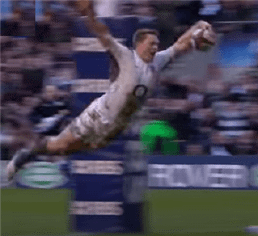You’ve probably noticed that rugby players often score by diving across the try line.
It’s not mandatory, so why do they do it? This article looks at the good reasons for diving to score. And the bad reasons which can lead to things going hilariously wrong.
Why Do Rugby Players Dive To Score Tries?
Rugby players dive to score a try to avoid being tackled in a way that prevents them from grounding the ball across the try line. It’s harder for defenders to tackle them across the sideline or to hold the ball off the ground.
Some players are known for exuberant dives to enjoy the moment.
Coaches generally advise against diving when it’s not necessary i.e. when there isn’t a defender near the player.
This is because a spectacular dive can lead to players dropping the ball before they touch it down. I’ll show you a hilarious example in the section on diving going wrong!
Diving is the shortest point from A to B
You’ll see plenty of tries being scored by the player racing across the line and slowing down to bending down to ground the ball. This is the safest way in terms of avoiding injury.

Simple physics tells us that diving downward from a few meters from the line is a faster and more direct way of scoring the try.
Diving to avoid being tackled
When a player is running upright across the line, the opposition defenders have a much better chance of tackling them from the side and pushing them out over the touchline. This saves a certain try!
The forward momentum from diving makes it much more likely for the ball-carrier to get the ball down.
Are defenders even allowed tackle a diving player?
You probably know that there are laws in rugby that protect players from being tackled in the air. Does that mean that the defender can’t even attempt to tackle the player when they’ve launched themselves into the air?
We address this in a separate article on tackling in the air in rugby. Referees won’t penalize a fair attempt to tackle a player who is horizontal in the air. Why not? Check out the linked article!
Good Technique When Diving To Score
The best technique for diving to score is to:
- dive downward
- keep the ball in both hands
- keep your eyes focused on where you want the ball to land.
Here is a picture that demonstrates good technique.

Arms close or extended?
You may see players keeping the ball tucked under an arm when diving. This is better technique when you’re close enough to the try line not to have to extend your arms.
You are less likely to hurt your arm or dislocate a shoulder this way (if the defender lands on you). You’re also less likely to drop the ball.
Poor Technique And Swan Dives
Commentators sometimes describe the act of diving to score as a “swan dive”.
This is because some players stretch their arms out wide with the ball in one hand. Think of a swan raising its wings.
This is poor technique because the ball must be held in one hand. The player is far more likely to drop the ball.
Ash Splash
Chris Ashton, the England winger, was famous for his swan dive. In his case, it was nicknamed the “Ash Splash”.

Aside from spreading his arms, he also dived upward to make the motion more spectacular. To be fair to the excellent winger, he never once dropped the ball (much to the disappointment of opposition fans!).
Players Who Dropped The Ball When Diving To Score
One of the most hilarious rugby bloopers occurred in the Hong Kong Sevens tournament. Japanese player Kosuke Hashino ran clear for a certain try. There wasn’t a defender in sight.
He exuberantly launches himself forward and flings out his arms in a spectacular swan dive. Unfortunately, he loses his grip on the ball and flings it away.
There’s nothing he can do when he lands on the ground except try to bury his head in the ground!
Check it out in the first example in this short but hilarious video. The good news is that his team was leading by a big score so it didn’t affect the result.
Why Don’t Players Always Dive For A Try?
If diving has advantages, why don’t players always launch forward into the air?
I mentioned the risk of dropping the ball, but there are other reasons to avoid diving.
Players can incur an injury if they land heavily on a tucked arm, although this is thankfully rare.
A common reason is that when players land on the ground, they slide forward at speed on the grass. This can result in grass burn i.e. abrasion and tearing to the skin. Trust me, this hurts!
Grass burn is more of an issue on hard dry grounds. On wet grounds, players can use the conditions to their advantage by sliding in from a distance.
Why Do Rugby Players Slide Over The Try Line From A Distance?
You’ll sometimes see players dive forward from five meters out of the line and slide across the grass to score. This is most likely to be seen in wet conditions on slippery grass.
But surely this is a slower way to score versus sprinting two more steps and making a shorter dive?
Players do this when they are being chased down by a defender behind them who they think will catch them if they stay on their feet.
By diving forward, they take their upper body out of reach of grasping hands. They just have to hope that their momentum will take them far enough along the grass to reach the try line.